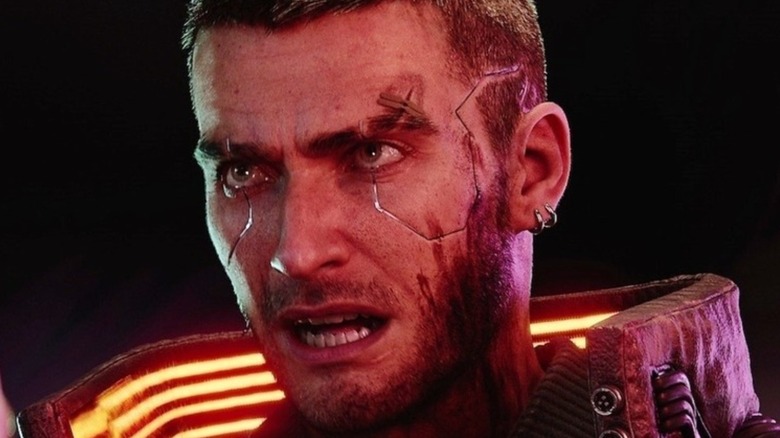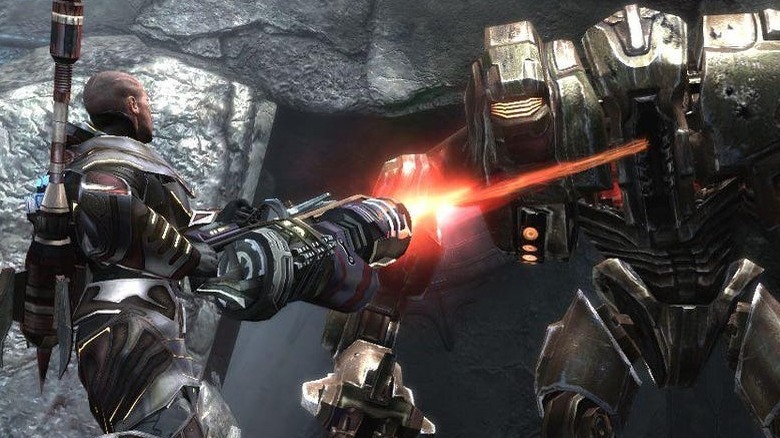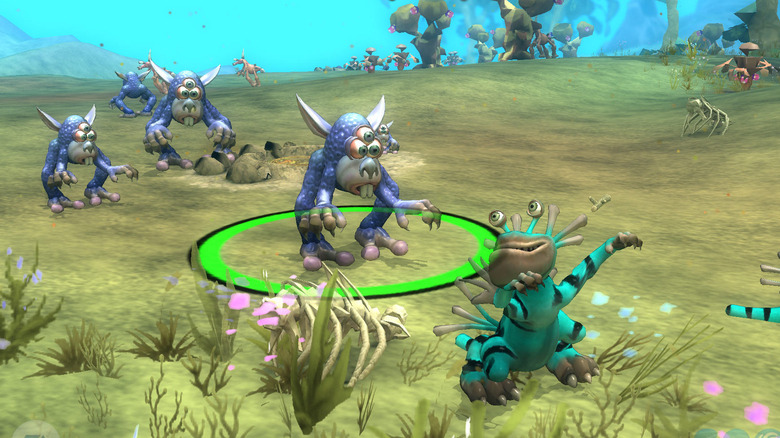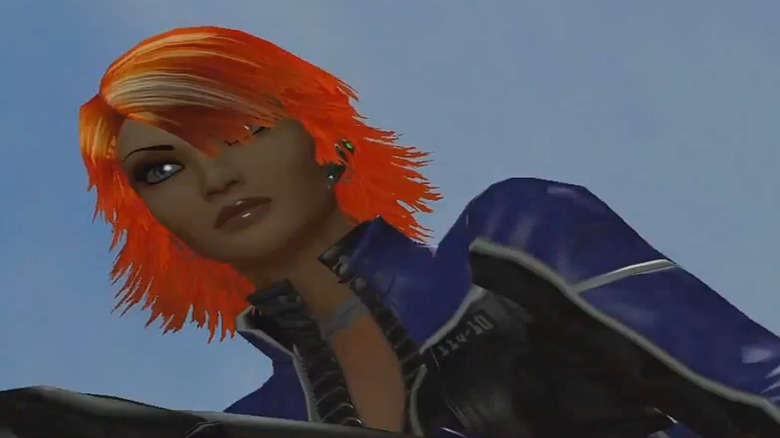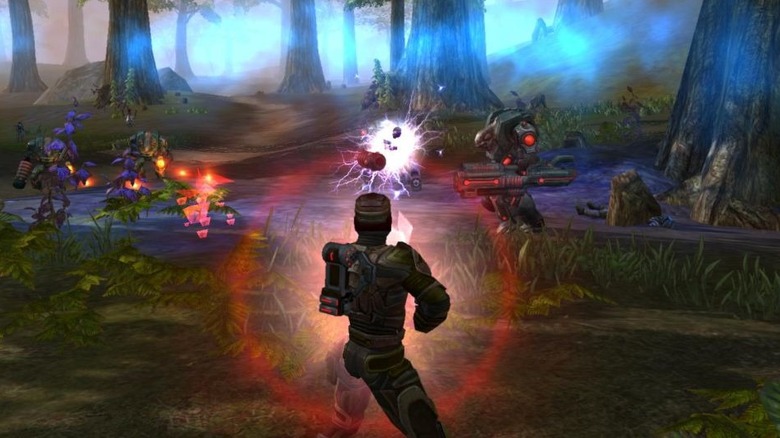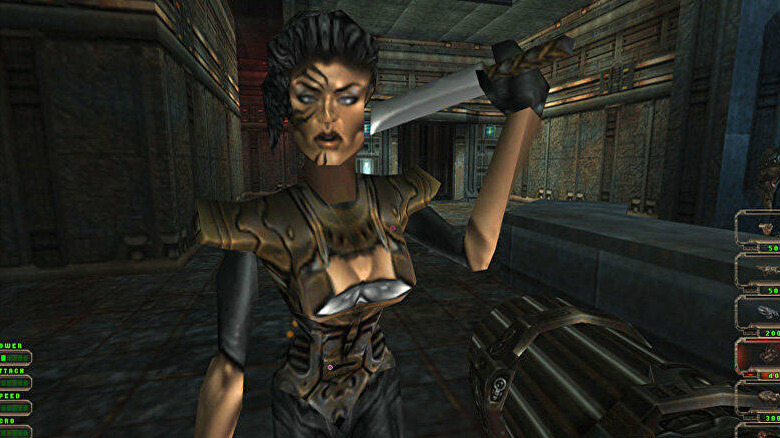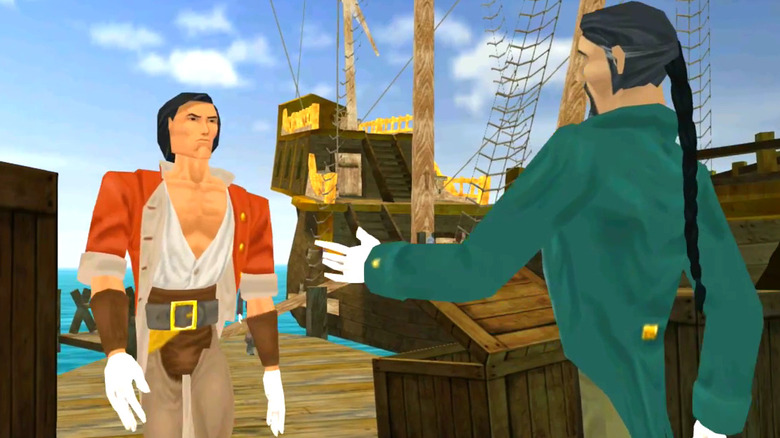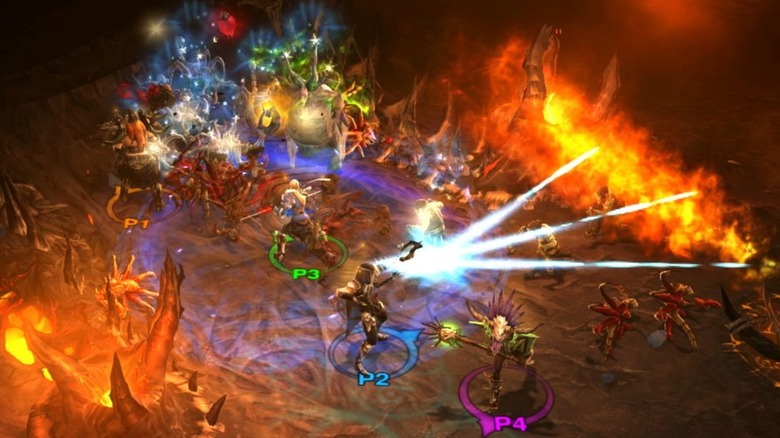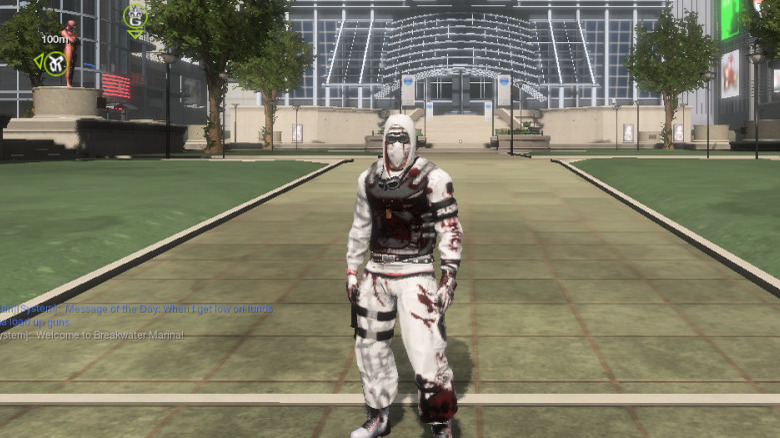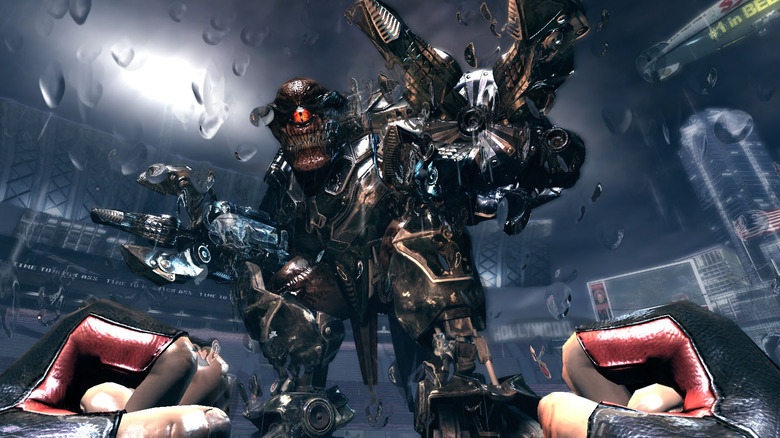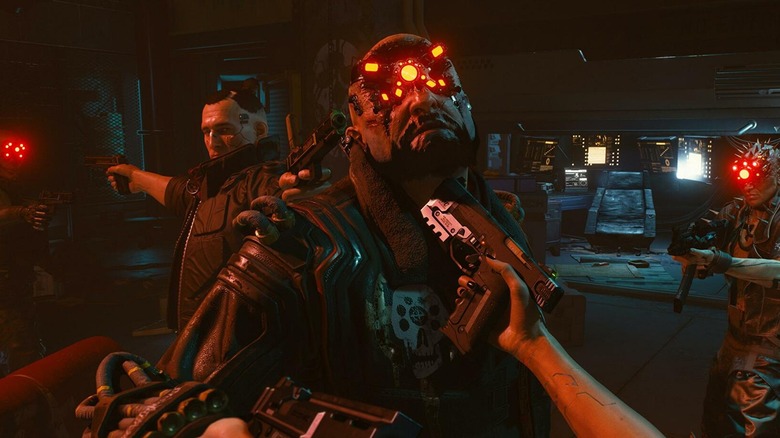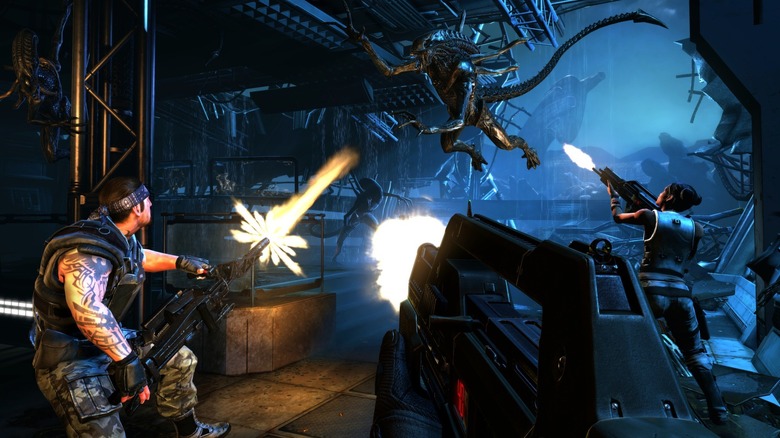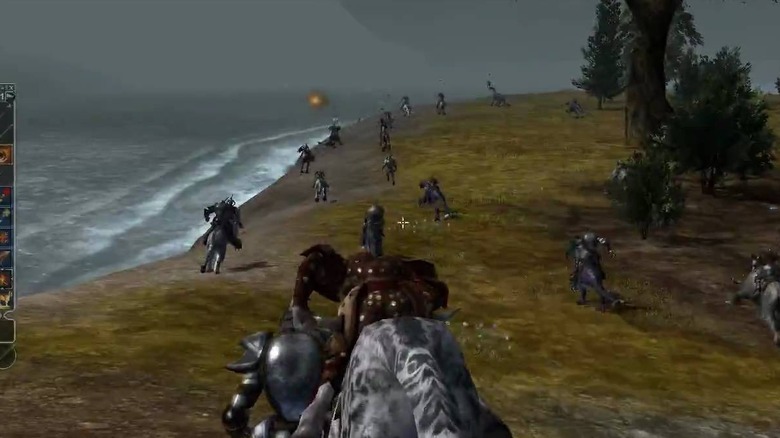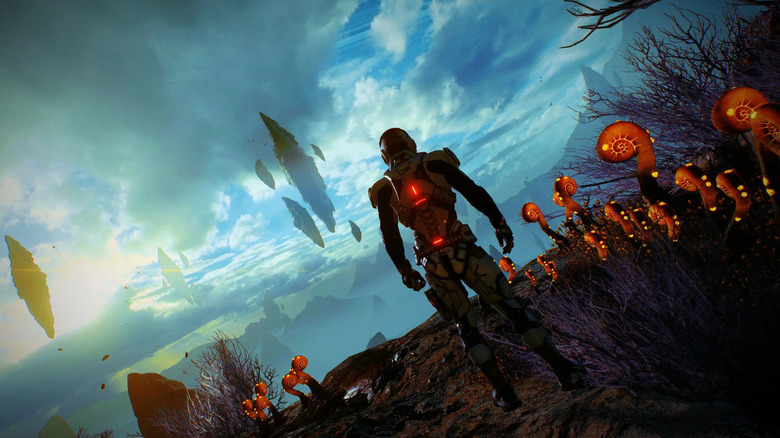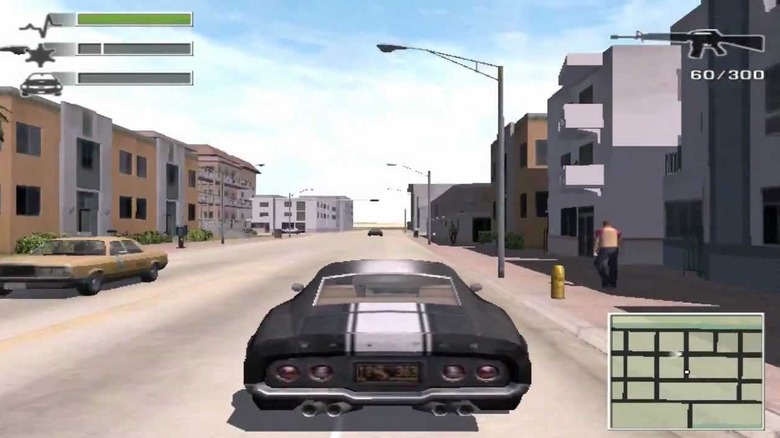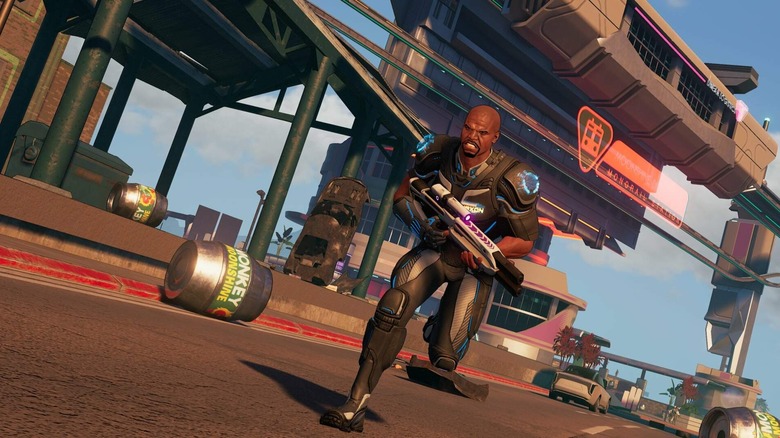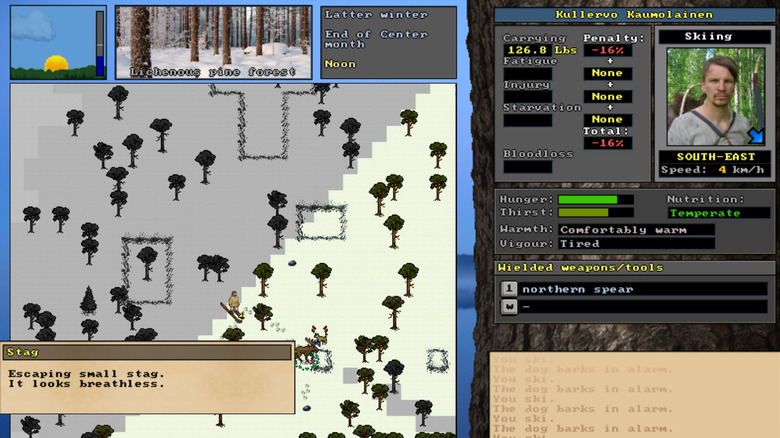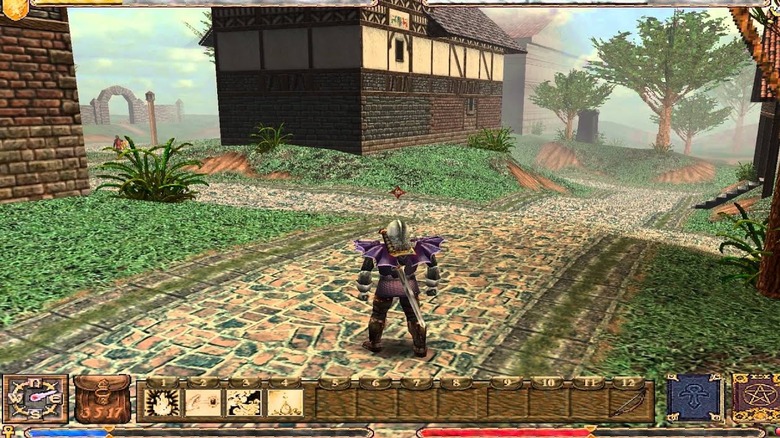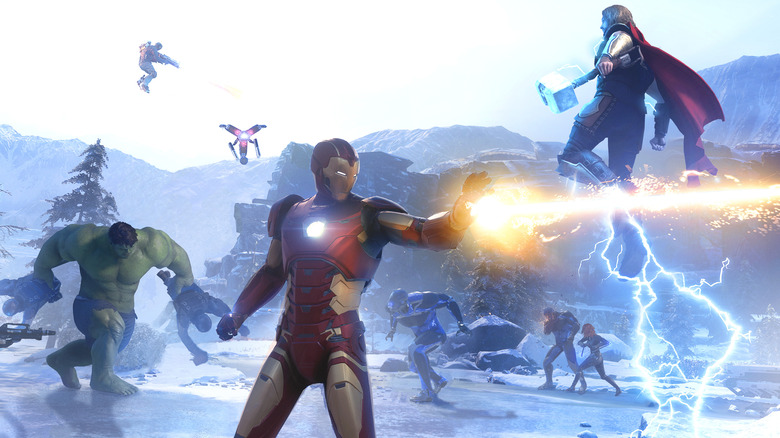Games With Ridiculous Delays That Still Turned Out Terrible
Making a video game is hard. First, an entire team of different personalities and skillsets need to be lined up on a single vision. Then, that team has to hope that said vision doesn't run afoul of any corporate priorities, or schedules, or budgets. Sometimes, even if the central idea is good, the technology simply isn't there to pull it off. And in the middle of all that, another game can come out that does the idea first — or does an entirely different idea that makes the team's game irrelevant. In many ways, it's a miracle that any game ever comes out at all.
But video games are an industry, and that industry has gotten pretty good at making sure that games they invest in release on-time. Even still, plenty of games get behind schedule, leaving publishers with a painful choice: release whatever the team has finished and hope for the best, or delay and miss out on a quarter's earnings. For the sake of game quality, usually the right choice is to delay!
But sometimes, those delays just keep piling up, until the game has essentially become an industry myth. And when at long last they see the light of day, they don't always measure up to the expectations or time that's gone into them. Here are games that had ridiculous delays yet still turned out terrible.
Too Human was mortal after all
Silicon Knights' "Too Human" never lacked for ambition. It drew from the third-person shooter and action genres, involved a complex loot system and multiple classes, told a sprawling science-fiction story rooted in Norse mythology, and was contained within a whopping four CD-ROM discs. Simply put, the game wanted to go big in every way. So big, it was supposed to start a trilogy. All that ambition came at a cost, though: the game, first unveiled at E3 1999 for the original PlayStation, didn't come out until 2008 as an Xbox 360 exclusive.
And the game we got after nine years of development wasn't exactly stellar. For one thing, combat was limited to the right thumbstick, which severely limited its complexity. For another, Silicon Knights removed all penalties for failure. If you died, you just stood right back up again, without losing anything. That made for a game both simplistic and unchallenging. Perhaps if the graphics or story had been amazing, "Too Human" could have redeemed itself. It didn't.
Silicon Knights chose to blame the whole thing on the makers of the Unreal Engine, Epic Games. They sued Epic for intentionally withholding the engine for years, alleging they did so to give Epic's own "Gears of War" franchise a leg up.
The lawsuit, too, spent years in development, and it, too, went poorly for Silicon Knights on release. At the end of it all, the judge actually ruled that Silicon Knights was the one in violation of the contract, and ordered a complete recall and destruction of the game. You couldn't play "Too Human" today if you wanted to.
Spore didn't spread very far
Will Wright is one of the industry's most legendary creators, the mastermind behind the original "SimCity" and so many other "Sim" games that followed. Where most games only focused on a few locations or a couple weeks of time, Wright's imagination extended out to sprawling simulations that took place over decades — or even centuries. So after scoping his design philosophy down to the level of a neighborhood for his best-selling "Sims" series, he decided to scope it way back up for his next project: covering the entire evolutionary span of a creature as it went from single-celled organism to space-faring sentient race. And for this, his most ambitious project, he would drop the "Sim" name altogether: the new game would only be called "Spore."
Obviously, such a colossal idea needed some time to germinate. Wright was actively working on the game as early as 2000, but the finished product wouldn't arrive until 2008. Part of that long development cycle went to the game's procedural generation techniques: Wright wanted the game to handle anything the gamer threw at it, from automatically animating the creature designs to populating an enormous galaxy of planets. In addition, the various life-stages of the player-made creature would each be its own game genre, and designing each one to be fun yet simple took time.
In the end, none of these elements added up to a particularly great game. Spore promised players all of evolution and all the galaxy, yet these elements were so simplified in the final product that it simply wasn't very interesting.
Perfect Dark Zero was far from perfect
Coming into the seventh-generation of consoles, Rare was one of the hottest first-person shooter developers in the world. Their legendary "GoldenEye" for the Nintendo 64 had redefined how a PC-bred genre could be transported onto consoles. Rare made a spiritual successor to that game with their own new intellectual property, "Perfect Dark," in 2000. "Perfect Dark" was widely hailed as a masterpiece and even today is considered a landmark title.
To no one' surprise, Rare began working on a sequel — or actually, a prequel — right after the first game launched. With their long-running relationship with Nintendo, this new game was intended for the Nintendo GameCube. But a hungry Microsoft, looking for top-tier talent to produce both children's and action games for the Xbox, acquired the studio in 2002. The new game, "Perfect Dark Zero," shifted development to the Xbox. However, with the new console generation on the horizon, the development shifted again to become a launch title for the new Xbox 360.
But even after five years of shifts between studios and entire companies, "Perfect Dark Zero" became a polarizing game on release. Some critics found it to be an unworthy and uninspired follow-up to such a beloved predecessor. Even as a launch-day shooter for the Xbox 360, "Zero" was eclipsed by "Call of Duty 2," which went on to be one of the best-selling franchises in gaming.
Tabula Rasa wiped its own slate clean
Richard Garriott de Cayeux helped to define the role-playing game genre in video gaming, bringing elements of popular tabletop games like "Dungeones & Dragons" into the virtual realm with his massively popular Ultima series. After a number of iterations in the franchise, he managed to open up the idea into networked multiplayer with "Ultima Online." This game got closer to the dream of living in a fantasy world than any other before it, bringing gamers from across the world together into one shared space. "Ultima Online" kicked off the entire massively multiplayer online (MMO) genre, which went on to dominate the industry for another decade.
So when Garriott de Cayeux formed Destination Games — a new studio built to make a new MMO called "Tabula Rasa" – fans' expectations were understandably high. But his vision went even further: he wanted to create no less than the "be-all, end-all MMO." A title that would be both massive in scope and intimate in detail, that would provide both a compelling individual experience as well as a sprawling world filled with millions of players, "Tabula Rasa" hoped to redefine video games all over again, as "Ultima" and "Ultima Online" had before it.
It was not to be. After six years of development, which involved large layoffs and shifts in the game's direction, "Tabula Rasa" released to only middling reviews and poor sales. The grand vision simply never cohered into a solid product. Less than two years later, the servers were shut down, rendering the game unplayable. Destination Games folded with the project's failure.
Mighty No. 9 didn't live up to its own name
Capcom's long-running "Mega Man" series is a pillar of the action-platformer genre. Over the decades, however, the franchise has spun-off many sub-series and shifted into a variety of designs very different from those simple, stellar, early titles. So when long-time "Mega Man" series producer Keiji Inafune left Capcom to found his own studio, he tried to return to the roots of what made that series great in the first place.
Of course, Inafune couldn't take Mega Man himself with him. But he did turn to the public for financial assistance in creating a brand new hero who looked a whole lot like the old one. "Mighty No. 9" was announced as part of a Kickstarter campaign, which blew away its original fundraising target of $900,000 by garnering nearly $4 million instead. Clearly, anticipation was sky-high.
And yet, despite being a retro game with relatively simple graphics, it took three years for the finished product to make it to gamers, including those who had donated to create the game in the first place. And once it was in their hands, the result wasn't what they'd hoped. Reviewers found the game frustrating and imprecise, which were the very opposite of the key ingredients of "Mega Man." "Mighty No. 9" became a parable of the Kickstarter era, a project with seemingly perfect pedigree that nevertheless proved that donors should be very careful with their money.
Daikatana didn't make anybody its... anything
Few games have had as big an impact on the industry as "Doom" and "Quake." "Doom" popularized the first-person shooter, setting new benchmarks for graphics and fast-paced design. "Quake" brought networked multiplayer games to the masses. The designer of both games was John Romero, who seemed to possess a sixth sense for what gamers wanted to play. When he left id Software to start his own company, Ion Storm, it seemed like a sure bet that he'd create the next masterpiece of the medium.
The project, called "Daikatana," was only supposed to take seven months. But Romero's design sensibilities, unbounded by any constraints like "budget" or "technical limitations," were far too large to fit that time-frame. He wanted a game that spanned multiple time periods, in which the player would travel the world alongside a variety of AI companions. In a way, Romero was being forward-thinking: that very pitch sounds a lot like modern games. But at the time, it was simply impossible.
After three long years, including a switch from the original "Quake" engine to the "Quake II" engine, "Daikatana" finally made it onto store shelves. But by then, Romero had already blown through all of Ion Storm's budget, and a spectacularly misjudged print ad campaign had damaged his reputation. "Daikatana" received only middling reviews, and was not a commercial success. Ion Storm shut its doors shortly thereafter. Romero had shot for the Moon...and wound up hitting Pittsburgh instead.
Galleon lumbered ashore late
After leading the design of the smash hit "Tomb Raider," Toby Gard left developer Core Design to start his own studio, Confounding Factor. Tomb Raider went on to be a breakout hit, a game with crossover appeal that brought in casual and hardcore audiences alike. As Gard began work on a new game, he wanted to preserve that sense of adventure and fun that he'd built into "Tomb Raider," while opening it up with a much larger world to explore and a richer narrative for the player to experience.
But the new game, called "Galleon," suffered a number of fits and starts. It kept switching consoles and engines, and as more time passed, yet more switches were needed. The team seemed to settle on a 2002 release date for the Nintendo GameCube, only for Gard to decide that his graphics were just too far behind the times, and eventually push the game to 2004. And by the way, now it was an Xbox exclusive. With a purpotedly small team, Gard's ambitions proved difficult to actually execute.
The result of it all was a game that, quite simply, wasn't very good. With a troublesome camera system and poorly-designed combat encounters, it felt like a game that had been rushed to the market. Yet it had taken over seven years to make. From the outside, it appears that Gard just didn't realize how much more complex game production had grown since his "Tomb Raider" days. The era of small teams unleashing AAA hits was over.
Diablo III was its own hardest difficulty mode
Hits don't get much bigger than Blizzard Entertainment's "Diablo" series. Marrying the fast-paced combat sensibilities of Doom with the aesthetics and reward systems of the RPG genre, Diablo redefined third-person action games and spawned a long list of imitators. "Diablo II" was an even bigger commercial success than the original, and cemented Blizzard's reputation as one of the industry's biggest studios.
The team at Blizzard North, which had created both "Diablo" games, got work on a third. But after several years in development, Blizzard's leadership in Irvine, California apparently decided that things weren't going well. In 2005, Blizzard shuttered its North studio altogether. While "Diablo III" production was moved down south, the game did not surface again for years, leading to speculation that development had essentially been restarted from scratch. "Diablo III" would not escape onto physical and digital shelves until 2012, having spent over a decade in development hell.
And for all that, its launch was a complete disaster. Even the game's single-player campaign had to be connected to Blizzard's servers, which led to endless disconnects in the first few weeks. Worse, the Auction House system, where players could sell loot earned in-game for real-world money, turned out to be a blight on the game's balance and the overall health of the community.
Had "Diablo III" remained in that launch state, it would have been a total failure. Fortunately, Blizzard spent years altering and patching the game, fixing the servers and removing the Auction House alongside a host of other changes large and small. The end result is a truly great game, salvaged from the wreckage of its own long development.
APB: All Points Bulletin never caught anyone
David Jones had produced a number of hits at a young age, including the lovable Lemmings and the original, top-down Grand Theft Auto. He eventually founded his own studio, Realtime Worlds, to produce the kinds of games he'd been dreaming of his whole career. After the blistering success of the Grand Theft Auto series, Jones was considered one of the hottest developers around. So his new game, "APB: All Points Bulletin," which would return to the idea of open-world design and the criminal underworld, could be the next GTA-sized hit.
But "APB" was hit with delay after delay. Originally shown off at E3 2005 with a target date of 2008, it was always intended to be a long development. But it took eight years for the title to finally launch as a PC-exclusive in 2010. By that point, it had ballooned into a full MMO game, complete with a subscription fee and the ability to bring millions of players together into a shared space.
The only problem? Those millions of players were nowhere to be found.
Critics found the final product to be buggy and broken, and the overall design was nowhere near as engaging as its "GTA" cousin. A few months after launch, only around 130,000 subscribers were playing the game, far beneath the target for MMOs at the time.
"APB" in no way lived up to the reputation of David Jones, but perhaps the hype had always been a bit misplaced. After all, Jones had only worked on the original "GTA," not the later megahits. Unfortunately for him, Realtime Worlds went into bankruptcy almost immediately after this game's launch.
Duke Nukem Forever really did take forever
When it comes to endless delays, no game is more famous than "Duke Nukem Forever." The follow-up to the popular and influential "Duke Nukem 3D" all the way back in 1996, Forever wanted to expand on that title's success and push the franchise farther. That much could be said of any sequel. But developer 3D Realms had bigger ambitions than that — much, much bigger.
While the studio first intended "Forever" to release in early 1998 with a pre-existing engine, the project then went through an endless number of engine changes, which kept pushing the release back. This was partly because the designers' vision was larger than what current engines could handle, and partly because they wanted Forever to have the best graphics on the market when it released. As the years passed and other games stole the first-person shooter spotlight, "Forever" was always struggling to catch up. 3D Realms simply refused to release what they had until it was the best game on the market. But that, of course, was a moving target they could never hit.
At long last, 3D Realms closed its doors, with "Forever" incomplete. The game was picked up by Gearbox Software, which just polished up the work that had already been done and released it in 2011.
Naturally, the game was universally panned for feeling like a relic from another time, which in point of fact, it was. Plus, its style of machismo hadn't aged well, and came across as crass and even misogynistic. Hardly the world's best game.
Cyberpunk 2077
The unprecedented success of "The Witcher 3" ensured that gamers would buy whatever CD Projekt Red was selling next. When members of the press first saw the incredible walkthrough video of CD Projekt's next game at E3 2018 — and when fans got to see a similar sneak preview months later — it seemed that "Cyberpunk 2077" couldn't miss.
"Cyberpunk 2077" was poised to be a revolutionary RPG and a mega hit. But delay after delay led to increasing speculation that CD Projekt Red's next masterpiece might be coming in too hot. And despite the numerous delays, the game ultimately shipped in a broken and rushed state, proving the devs probably should have taken a bit more time. The many promises of "Cyberpunk 2077" were too good to be true.
The disastrous launch of "Cyberpunk 2077" in December 2020 resulted in an industry-wide kerfuffle. The PC release, though by far the most stable, was still buggy and full of glitches that developers knew about months in advance, but couldn't fix in time. On older generation consoles, "Cyberpunk 2077" was virtually unplayable. This led to the game's infamous removal from the PlayStation Store by Sony. The game is certainly better now (per Polygon), but it's going to take a lot for it to live down its reputation and regain favor in the eyes of many fans.
Aliens: Colonial Marines
There have been countless underwhelming attempts to turn the "Alien" franchise into a video game over the years, but one subpar title stands tall among the trash heap: Gearbox Software's "Aliens: Colonial Marines." This co-op "Aliens" shooter had a tumultuous development cycle from 2007 to 2014. It was developed at Gearbox that whole time, a period during which the studio also shipped the infamous "Duke Nukem Forever." In the time it took to finish "Colonial Marines," the company released two "Borderlands" games and finally let Duke die.
Originally conceived as a project dedicated to preserving the legacy of James Cameron's classic "Aliens," "Colonial Marines" ended up being considered one of the worst games of all time (per The Escapist). Upon release, the game was lambasted by critics for its lack of ambition and its copious amount of bugs and glitches. Co-op felt tacked on to levels that weren't designed for it, the story lacked continuity with even the most basic of "Alien" lore, and the worst part was that the Xenomorphs weren't even scary. Quite the opposite, in fact, as many critics found the AI in "Aliens Colonial Marines" to be lacking in intelligence and strategic pathing.
Nothing about "Colonial Marines" got fans of first-person shooters or "Aliens" excited enough to do much more than forget it and move on.
Darkfall Online
"Darkfall Online" was a failed MMO RPG by Greek independent studio Aventurine SA. The MMO spent over a decade in active development, from pre-production to the game's final days online in 2012. Like its contemporary "Ultima Online," the ambitious open world RPG aimed to emphasize open PvP on a large scale and encourage role-playing. Unfortunately, "Darkfall Online" released to pretty abysmal reviews from the UK games press. It was shut down less than 3 years later, clearly not cut out to compete in a post "WoW" landscape. Over the years, the IP has been rebooted and revived by other studios (currently as "Darkfall: Rise of Agon"), but still has never caught on in a mainstream sense.
Issues like poor account management, an ever-growing queue of players, and other connectivity problems (per Game Developer) placed "Darkfall" in a sorry state from day one. Balance issues and other fixable gameplay complaints were identified by the community, but the "Darkfall" developers were not equipped to handle the community's needs. Maybe the success of "World of Warcraft" simply pushed MMOs in a direction that left "Darkfall Online" feeling like a relic.
Mass Effect: Andromeda
One of the most unforgettable gaming flops in recent memory was the 2017 launch of "Mass Effect: Andromeda." Initially planned as a hot-on-the-heels "Mass Effect" spin-off far removed from the events of the trilogy, "Andromeda" instead kind of rode the coattails of Bioware's mega-hit franchise and crashed it into the ground. While "Mass Effect 3" made some questionable decisions, it's controversial ending wasn't the thing that killed the series for half a decade. That was "Andromeda."
Trying to piggyback off the popularity of the trilogy only led to the game's tumultuous development getting process stretched further and further (per Kotaku). By the time "Mass Effect: Andromeda" saw the light of day, it had been five years since "Mass Effect 3" — and clearly, it needed even more time to bake. Filled with game-breaking and immersion-wrecking bugs, "Andromeda" was a legendary mess. The "Mass Effect" series has still not recovered from the damage done by "Andromeda's" launch. Even as it got patched, any groundswell of enthusiasm the game could have garnered was long gone by the time it was in a working state.
Ironically, EA had said in 2016 that it would happily delay the game again if it meant delivering a better player experience overall (via GameSpot).
Driv3r
Did "Driv3r" kill the "Driver" franchise? If you are reading this and have no idea what "Driver" even is — then yes, there is a fair chance it did. While not the last game in the open-world driving series — that honor goes to the bizarre cult favorite "Driver: San Francisco," — the third "Driver" game is where the series attempted to go full "Grand Theft Auto" clone. Already by its third entry, almost everything that was special about the franchise had been erased from it.
The original "Driver" launched on PlayStation in 1999 to rave reviews (via IGN), heralded at the time for its graphical fidelity and variety of game modes. Its Director Mode was something of a precursor to user-generated content technologies like Machinima and modern day photo modes, allowing players to create and edit their own action set pieces. First slated for 2003, "Driv3r" was pushed to 2004 that summer by publisher Infogrames (via GameSpot). No exact date was announced, but a further delay was announced in January 2004, pushing the game to an ultimate release date of June 2004.
That June, reviews criticized the game for its lack of focus on driving, leading to unfavorable comparisons to "GTA." A focus on on-foot action and shooting felt like it betrayed what the series was all about in the first place. "Driv3r" even failed to impress at a technical level, with its graphics falling short of other games in the PS2 era.
Crackdown 3
In early 2007, a bunch of thirsty "Halo" fans spent $60 on "Crackdown" strictly in order to get into the "Halo 3" beta (per Engadget). What they realized when they finally got around to playing the game was that it was full of satisfying open-world urban chaos. It was a silly game that sparked in the moment, but the sequels haven't been able to recreate that magic. After the average "Crackdown 2," the third iteration of the series was stuck in development for years. When it finally came out in 2019, years after its original 2014 announcement, "Crackdown 3" was a huge letdown.
The open-world action game took the idea of going back to basics a bit too literally. While "Crackdown 3" let you take pleasure in orb collecting and frame-rate-killing explosive action, the end result felt repetitive and dated. The PC Gamer review said, "'Crackdown 3' comes along 12 years after 'Crackdown,' but without 12 years' worth of new ideas to share." Years of uncertainties and complications led to yet another "Crackdown" title stalling in its tracks — fun by the standards of 2007, but not doing anything unique or innovative.
UnReal World
"UnReal Worl" was in development for over 20 years before it saw final release in 2016 (via PCGamesN). This survival game experimented with many genres and ideas throughout its lengthy development cycle. Unfortunately, by the time "UnReal World" was released on Steam its once-revolutionary ideas seemed much more tame and generic. While it has recieved largely positive reviews from players (via Steam), the game came and went without much discourse. The niche art style certainly isn't for everyone, but "UnReal World" is a fascinating passion project.
The history of "UnReal World" has thankfully been chronicled in detail by its developers. "UnReal World" began life as a medieval fantasy RPG but changed gears numerous times before landing on the final idea. Systems were added and removed and the setting wound up being the iron-age in the far northern region of the world. With more of a focus on agriculture and crafting, the end game began to take shape. Survival games were huge by 2016, when "UnReal World" came to Steam. The saturation of that market is just one possible explanation for why this labor of love failed to catch fire.
"UnReal World" might not actually be terrible, but it has failed to catch on with a large number of players, some of whom find it to be too slow in its payoffs and frustrating from a combat standpoint. It's all a matter of perspective, but one has to wonder if the game would have connected with more players if it had come out sooner.
Ultima 9
The finale of Richard Garriot's foundational role-playing series came out in 1999, five years after its predecessor "Ultima VIII: Pagan" — an eternity in 90s video game development time. According to The Cutting Room Floor, this cursed game was held up numerous times by the departure of several key figures behind the scenes. In between "Ultima 8" and "Ultima 9," the MMORPG "Ultima Online" came out in 1997 and proved to be have more staying power than any "Ultima" sequel of the late '90s (per RPS).
"Ultima IX: Ascension" was released to a slew of 5 and 6 range review scores (per Game Rankings), which is a pretty negative review score for a game in a long-running franchise by the standards of 1999. The game was critiqued for its poor combat system and performance issues. While it looked beautiful for its time, the game was disappointing in pretty much every other regard, from the technical bugs to the lack of the tight design that had made the series so important for PC gaming. "Ultima IX" should have been an important genre-defining title, hyped up as the finale in a beloved series, and yet it more or less was the final nail in the "Ultima" coffin.
Marvel's Avengers
Announced in January 2017 as an untitled "Avengers" video game, the Crystal Dynamics-developed and Square Enix-published take on the world's most popular superhero group almost immediately went radio silent for a long while. Two and a half years after the initial announcement, "Marvel's Avengers" was finally first shown off at E3 2019. Responses to the demo were cautiously optimistic at first (via PC Gamer), but a delay from May 2020 to September of that year seemed to be an indication that this superhero adventure was doomed from the start. Eventually the game was released on September 4, 2020.
When "Marvel's Avengers" came out, critics didn't have the nicest things to say about it. The story and action were decent, making them the highlights of the experience. However, a majority of the reviewers were especially critical of its reliance microtransactions and loot boxes, both of which seemed to be tacked on to a game that was felt like it was meant to be a single-player game at some point.
A pretty big indictment of the game's appeal is the fact that it wasn't even a hit one year after "Avengers: Endgame" broke box office records (per Box Office Mojo). Even adding popular characters like Black Panther to "Marvel's Avengers" hasn't been enough to give the game a second life, and its playerbase has fallen off drastically since its release.

